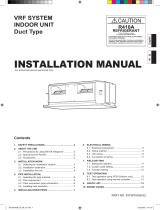
En-2
1. SAFETY PRECAUTIONS
• Be sure to read this Manual thoroughly before installation.
• The warnings and precautions indicated in this Manual
contain important information pertaining to your safety. Be
sure to observe them.
• Hand this Manual, together with the Operating Manual to
the customer.
Request the customer to keep them on hand for future
use, such as for relocating or repairing the unit.
WARNING!
This mark indicates procedures which, if
improperly performed, might lead to the
death or serious injury of the user.
• Request your dealer or a professional installer to install
the unit in accordance with this Manual.
An improperly installed unit can cause serious accidents
such as water leakage, electric shock, or fi re.
If the unit is installed in disregard of the instructions in
the Installation
Manual
, it will void the manufacturer’s
warranty.
• Do not turn ON the power until all work has been
completed.
Turning ON the power before the work is completed can
cause serious accidents such as electric shock or fi re.
• If refrigerant leaks while work is being carried out,
ventilate the area.
If the refrigerant comes in contact with a flame, it
produces a toxic gas.
• Installation work must be performed in accordance with
national wiring standards by authorized personnel only.
• Except for EMERGENCY, never turn off main as well
as sub breaker of the indoor units during operation. It
will cause compressor failure as well as water leakage.
First, stop the indoor unit by operating the control unit,
converter or external input device and then cut the
breaker.
Make sure to operate through the control unit, converter
or external input device.
When the breaker is designed, locate it at a place where
the users cannot start and stop in the daily work.
CAUTION!
This mark indicates procedures which,
if improperly performed, might possibly
result in personal harm to the user, or
damage to property.
2. ABOUT THE UNIT
2.1. Precautions for using the R410A
refrigerant
WARNING
• Do not introduce any substance other than the prescribed
refrigerant into the refrigeration cycle.
If air enters the refrigeration cycle, the pressure in the
refrigeration cycle will become abnormally high and cause
the piping to rupture.
• If there is a refrigerant leakage, make sure that it does not
exceed the concentration limit.
If a refrigerant leakage exceeds the concentration limit, it can
lead to accidents such as oxygen starvation.
WARNING
• Do not touch refrigerant that has leaked from the refrigerant
pipe connections or other area. Touching the refrigerant
directly can cause frostbite.
• If a refrigerant leakage occurs during operation, immediately
vacate the premises and thoroughly ventilate the area.
If the refrigerant comes in contact with a flame, it produces a
toxic gas.
2.2. Special tool for R410A
WARNING
• To install a unit that uses the R410A refrigerant, use
dedicated tools and piping materials that have been
manufactured specifi cally for R410A use.
Because the pressure of the R410A refrigerant is
approximately 1.6 times higher than the R22, failure to use
dedicated piping material or improper installation can cause
rupture or injury.
Furthermore, it can cause serious accidents such as water
leakage, electric shock, or fi re.
Tool name Contents of change
Gauge manifold
Pressure is huge and cannot be
measured with a conventional gauge.
To prevent erroneous mixing of other
refrigerants, the diameter of each port
has been changed.
It is recommended to use a gauge
manifold with a high pressure display
range –0.1 to 5.3 MPa and a low
pressure display range –0.1 to 3.8 MPa.
Charging hose
To increase pressure resistance, the
hose material and base size were
changed.
Vacuum pump
A conventional vacuum pump can be
used by installing a vacuum pump
adapter.
Be sure that the pump oil does not
backfl ow into the system. Use one capable
for vacuum suction of –100.7 kPa (5 Torr,
–755 mmHg).
Gas leakage
detector
Special gas leakage detector for HFC
refrigerant R410A.
2.3. Accessories
WARNING
• For installation purposes, be sure to use the parts supplied
by the manufacturer or other prescribed parts.
The use of non-prescribed parts can cause serious accidents
such as the unit to fall, water leakage, electric shock, or fi re.
• The following installation parts are furnished. Use them as
required.
• Keep the Installation Manual in a safe place and do not
discard any other accessories until the installation work has
been completed.






















